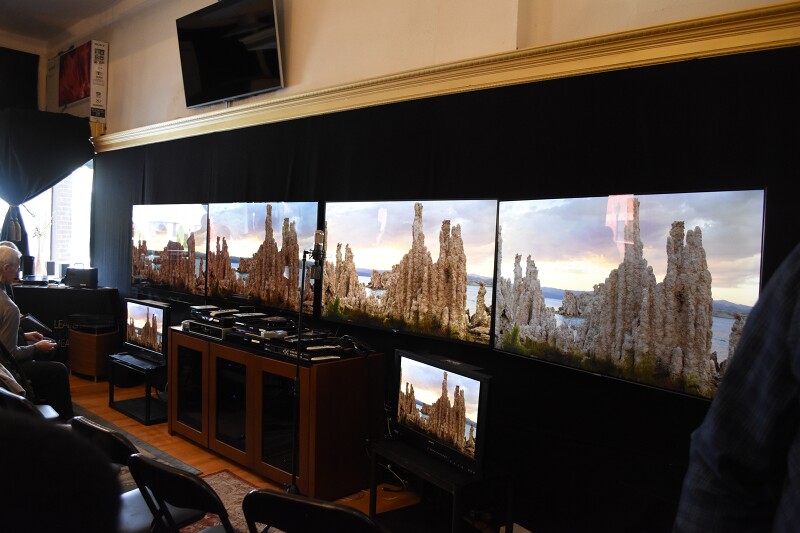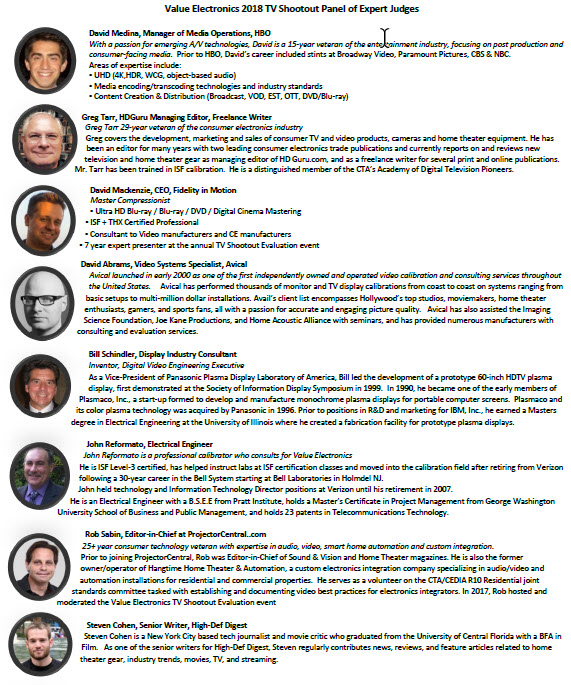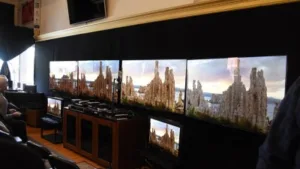Last Sunday (September 23rd), Value Electronics (VE) held the TV shoot-out it began in 2007. Normally, the shoot-out is attached to a technology show in New York, but it was held this year at VE’s showroom in the wealthy New York suburb of Scarsdale. VE is a high-end video and audio integrator and dealer, and Scarsdale is just the sort of town in which it can prosper.

The shoot-out has become far more than a local event, with representatives of the major TV manufacturers, Hollywood, video distribution, calibration, and tech media communities participating, attending, or watching via webcast. The shoot-out is widely known in these industries. It is widely respected but also has its detractors. This year, VE’s showroom was filled.
The participating sets (with MSRP) were:
- LG OLED65E8P, 65″ OLED, $3499
- Sony XBR-65A9F “Master Series” 65″ OLED, $4495
- Sony XBR-65Z9F “Master Series” 65″ LCD, $4499
- Samsung QN65Q9FN 65″ QLED (LCD) TV, price reduced to $2999 or less from ~$3400
I was not familiar with the Sony Z9F. This set has a full-matrix backlight, but I have not been able to find out how many zones it has. (and Sony didn’t reveal it when it launched the Master series Sony Seeks Kando with New Master Series TVs) The wide color gamut is created by RG phospor enhancement of the blue LEDs. The red phosphor may be GE’s TriGain phosphor.
For most of the tests, we were asked to compare the images on the four sets being evaluated against the industry-standard Sony BVM-X300 30″, 4K. RGB OLED grading monitor, which has a peak output of 1000 cd/m² (Fig. 1). Incidently, the price of the BVM-X300 has recently gone up to $45,000. VE owner Robert Zohn noted that renting each of the two monitors for the shoot-out cost $4,000.
The sets were calibrated by well-known calibrators The monitors were set to BT Rec.709 with Sony white-point offset. The offset gives the sets white points that are “perceptually matched,” compensating for differences in spectral power distribution. (Sony has a white paper on-line, said Zohn.)
 Fig. 1. The VE TV Shoot-out. The four sets being evaluated are in a row, and the two Sony grading monitors are beneath them.
Fig. 1. The VE TV Shoot-out. The four sets being evaluated are in a row, and the two Sony grading monitors are beneath them.
(Photo: Ken Werner) Click for higher resolution
We were asked to evaluate the sets in three different modes: SDR day Mode (Best Living Room TV), SDR Reference Mode (Best Home Theater TV), and HDR Reference Mode (Best HDR TV). There were 4 or 5 tests for each mode, and all tests were based only on visual observation.. Although it is clear why some of the tests are associated with a particular mode, I don’t find this clear for all of them.
Finally the “best” winners were determined by the votes of nine expert judges (Fig. 2), and these votes were then combined with the votes of the rest of us.
 Fig. 2 The panel of experts. Click for higher resolution
Fig. 2 The panel of experts. Click for higher resolution
The results are in Figs. 3 – 5. The tests for the SDR Day Mode are mostly self-explanatory. I thought the motion handling of both LCD sets was worse than the expert judges did, and I was more bothered by the reduced peak brightness of the OLEDs than they were.
 Fig. 3 Experts’ result
Fig. 3 Experts’ result
 Fig 4. Combined result from Judges and Audience
Fig 4. Combined result from Judges and Audience
 Fig. 5 Overall Result
Fig. 5 Overall Result
The SDR Reference Mode shadow detail test was a frame from “The Deathly Hallows, Part 2” (I think). A large crowd of ghoulish characters is standing on a hill, The head ghoul in the center has ghostly face with a ghostly pallor. The other ghouls spread out to either side and behind them, and they are very, very dark. One of the movie guys in attendance said this is the darkest scene that he knows of in any movie.
Our task was to evaluate the gradations of black in the robes of the ghouls. Both OLEDs crushed the darkest levels but their overall rendition was still pretty good. The Sony Z9F was virtually indistinguishable from that of the reference grading monitors, and I rated it higher than the expert judges did. The Samsung Q9F exhibited very strange behavior. Below a certain threshold, the set turned off its backlight zones, so the lower left sixth of the screen was completely black and all detail was lost. The area that was not blacked out was still very much darker that the image on the monitor and the other sets. This scene was unwatchable (as well as nearly unseeable), and I rated it even lower than the expert judges did. Samsung needs to re-tune its algorithm for the next model year.
The black-level perceived contrast test was a freeze frame from “Gravity”, in which Sandra Bullock’s brilliantly reflecting space suit recedes rapidly into the black of space. I have no quarrel with the expert judges here, but I was struck by something we weren’t voting on. Sandra is set against a rather dense star field, and on the Samsung set there is a strong halo effect. The Sony Z9F was considerably better here, and the OLED sets were best of all. This is puzzling since the substantial changes Samsung made in the Q9 for 2018 were intended to cure the halo problems of the 2017 model.
Three days later, at the Vehicle Displays and Interfaces conference in Livonia, Michigan, Shin-Tson Wu and two of his students from the University of Central Florida, presented a paper that concluded a 12.3″ display with a native 2000:1 CR needs about 950 dimming zones to “exceed the human perception limit of halo effect. If you are reading this, Shin-Tson, how many zones does a 65” TV panel need?
BTW, my choice for best display was not the same as the expert judges, but I ain’t talkin’.
For a complete report on the Vehicle Displays Conference, see the upcoming issue of Mobile Display Monitor. – Ken Werner
Analyst Comment
If I remember correctly, HDR pioneer, Brightside, which was bought by Dolby when it was developing Dolby Vision, had patents on the algorithms needed to use the correct number of LEDs to take account of the veiling glare in human vision and therefore make an LCD backlit panel look as good as possible, with minimised halos. I wonder if this patent situation is related to the visible artefacts on the Samsung set? The most likely issue is probably cost. Samsung clearly knows how to make a very good looking LCD TV with a lot of zones, as it showed one privately in its Innovation Room at CES last year. It’s only the second time I have ever seen an LCD that was clearly better than an OLED (the first was a demo by Eizo of a grading monitor at IBC in 2017). (BR)
Ken Werner is Principal of Nutmeg Consultants, specializing in the display industry, manufacturing, technology, and applications, including mobile devices, automotive, and television. He consults for attorneys, investment analysts, and companies re-positioning themselves within the display industry or using displays in their products. He is the 2017 recipient of the Society for Information Display’s Lewis and Beatrice Winner Award. You can reach him at [email protected].

